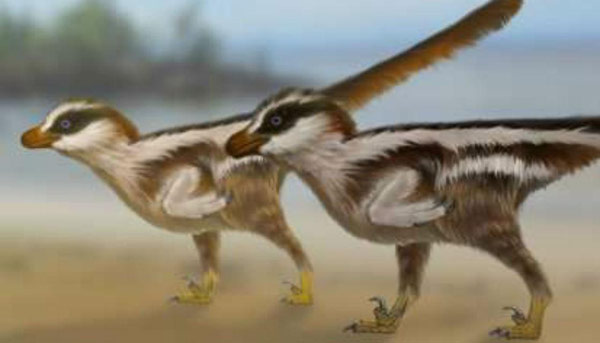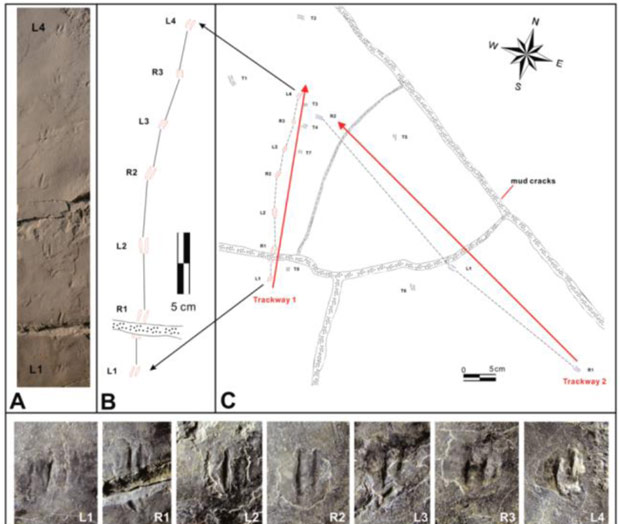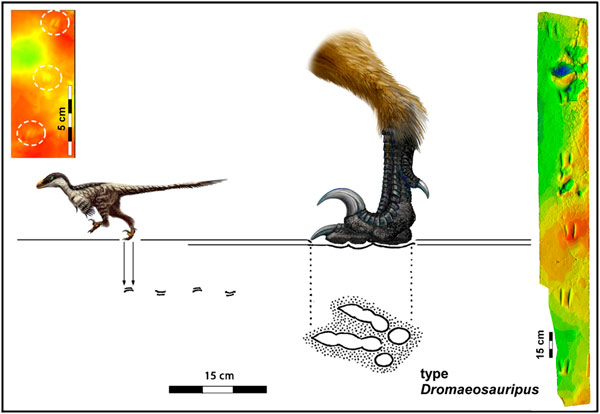A New Tiny Dromaeosaurid Ichnogenus Dromaeosauriformipes
Catching up with our reading of scientific papers over the weekend and our attention was caught by the description of tiny, two-toed prints from South Korea that reaffirm the growing conviction amongst scientists that some types of non-avian dinosaur were very small, not much bigger than sparrows. The footprints might be the smallest dinosaur tracks discovered to date.
Writing in the academic journal “Scientific Reports”, researchers from South Korea, in collaboration with colleagues from Australia, China, Spain and the USA, describe eighteen diminutive, didactyl tracks that are attributed to either juveniles or tiny adult dinosaurs that may have had a hip height of around five centimetres.
Dinosaur Tracks
The tracks have been ascribed to a new ichnogenus – Dromaeosauriformipes (D. rarus), the name translates as similar in form to Dromaeosauripus*, small and rare.
A Life Reconstruction of the Recently Described Dromaeosauriformipes rarus
Picture credit: Anthony Romilio (Queensland University)
Dromaeosauripus* is an earlier described ichnogenus representing a larger set of tracks, three ichnospecies have been assigned to this ichnogenus to date.
Dromaeosauriformipes rarus – A Microsaur
The tracks were originally found by Professor Kyung Soo Kim (Chinju National University of Education, South Korea), one of the authors of the paper. The tracks come from a series of remarkable multiple track-bearing horizons from the JinJu Formation of the south-eastern part of the Korean peninsula. The deposits represent lakeshore sediments (Lower Cretaceous) and date from approximately 115 million years ago (Aptian faunal stage).
The trackways criss-cross an area that was once soft mud and the eighteen tracks are interpreted as representing an estimated 6 to 10 individual trackways possibly made by a similar number of different individuals. It is suggested that the prints could resemble a Microraptor-like dromaeosaurid (microraptorine). Some scientists have suggested that Microraptor was piscivorous (fish-eating). The tracks found in association with a lakeshore, could represent a Microraptor-like dinosaur searching for food, but equally the tracks could represent other types of activity.
Microraptorine Activity in Lakeshore Setting (D. rarus)
Picture credit: Scientific Reports – original photo (A) by Professor Kim
The picture shows (A), the seven print trackway of the diminutive dromaeosaurian Dromaeosauriformipes rarus. A line drawing of the trackway is shown (B) and (C) shows a line drawing of the track-bearing surface showing two tiny tracks but trackway 2 has a much bigger stride length indicating greater velocity than recorded in trackway 1. Pictured below are seven photographs recording the individual prints.
One of the authors of the scientific paper, Dr Anthony Romilio from the University of Queensland stated:
“They are the world’s smallest dinosaur tracks. These new tracks are just one centimetre in length, which means the dinosaur that made them was an animal you could have easily held in your hand.”
Hatched from Tiny Eggs
To estimate the size of the dinosaur that made the tracks, the team measured the footprint length and multiplied the value by 4.5 to get an approximate hip height. The maker(s) of these tiny tracks would have had a hip height of around five centimetres. The two-toed prints are definitively dromaeosaurid, as the second toe, the killing claw, is held off the ground as the dinosaur moves about, hence just two toe impressions are left behind in each print. In the paper, the scientists comment upon the fact that these tiny dinosaurs must have hatched from very small eggs.
Back in 2016, Everything Dinosaur featured the discovery of tiny three-toed theropod prints that had been discovered in Lower Cretaceous sediments from south-western China. As a result, a new “tiny-saurus” ichnogenus was erected – Minisauripus. The South Korean prints assigned to Dromaeosauriformipes rarus are even smaller.
To read about the earlier discovery of tiny dinosaur footprints from south-western China: Minisauripus – the Smallest Dinosaur Known?
Professor Kyung Soo Kim commented that the lake deposits at this location created ideal conditions that allowed for the preservation of tiny footprints, rarely found anywhere else in the world.
Professor Kim added:
“In addition to tiny dinosaur tracks, we have footprints made by birds, pterosaurs, lizards, turtles, mammals, and even frogs.”
Comparing the Tracks of Dromaeosauriformipes rarus with Dromaeosauripus jinjuensis
Picture credit: Scientific Reports
The image above compares illustrations of the tracks of Dromaeosauriformipes rarus to the size of the trackways assigned to Dromaeosauripus jinjuensis. Note the raised second toe which produces the characteristic two-toed print. D rarus tracks suggest a much smaller dromaeosaur produced the tracks. The image in the upper left is a colour photogrammetric image of Trackway 1 which helps to define track depth and characteristics. This is compared to the photogrammetric colour image showing the type trackway of D. jinjuensis (right).
Are These Tiny Dinosaurs or Newly-Hatched Dinosaurs from a Much Larger Species?
The tracks support the idea that there may have been lots of very small dinosaurs, but their small bones would not necessarily be preserved in the fossil record so there may be a bias towards larger members of the Dinosauria due to their greater preservation potential. However, if conditions are right, then diminutive prints and tracks can be preserved, providing tantalising evidence to support the idea of a much more diverse Theropoda then previously thought. The researchers raise two fascinating questions in their published paper:
- What is the size range of “raptor” tracks based on footprints or inferred from skeletal remains?
- How might diminutive tracks of juveniles be distinguished from the prints made by tiny adults (microsaurs)?
Co-author Dr Martin Lockley (University of Colorado Denver’s College of Liberal Arts and Sciences), suggests that these tiny trackways could represent the prints of adult dinosaurs.
He commented:
“Rapidly growing dinosaurs don’t remain small or leave little footprints for very long. But of all of the footprints we’ve found of the Minisauripus, none grew larger than one inch; a preponderance of evidence of a small species and not babies. There’s a chance that we just found something smaller.”
For models and replicas of “raptors” and other prehistoric animals: Beasts of the Mesozoic Models and Figures.









Leave A Comment